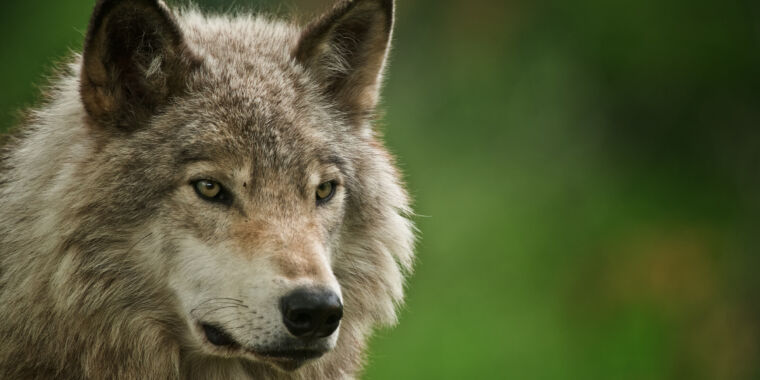
Man’s best friend was the first of many animals that humans domesticated. But there was never a clear before-and-after moment where the dogs suddenly became a distinct group of wolves. While some of the ancient skeletons are clearly dogs, there were plenty of mysterious skeletons before that. It is possible to find out what happened using the genome Of modern and ancient dogs. But that analysis depends largely on what you think wolf dogs derive from the shape.
Now, researchers have come up with a much clearer picture of the last 100,000 years of wolves’ evolution. The picture it paints is a population that has remained one unit despite spreading across continents in the Arctic, with populations sporadically recovering from a core centered in Siberia. Many dog breeds appear to be derived from a group of East Asian wolves. But others also appear to have received significant input from Middle Eastern populations – but it is unclear whether these populations were wolves or dogs.
Wolves around the north
The ability to sequence ancient DNA was essential to this new work, which included obtaining DNA from 66 wolf skeletons that collectively span about 100,000 years of evolution, including most of the last Ice Age. Wolves are found in the Northern Hemisphere, and the skeletons used here tend to be closer to the North Pole (perhaps in part because their DNA survives better in colder climates). But it is widely distributed, with representation in Europe, Asia and North America. The researchers also included five ancient wolf genomes analyzed by others, along with some modern wolf genomes.
Typically you would expect to find regional populations that do not often mix with their distant relationships. If you identify the most closely related genomes, you will usually find that they cluster together. This is not the case here. Instead, the ancient wolf genomes huddled together in time. That is, it was likely to be a wolf closely related to other wolves alive around the same time, regardless of where on the planet those wolves lived.
Studies of modern wolves have indicated that the local population evolved after the last peak of the last Ice Age. But all of these populations are more similar to each other than wolves that existed before the peak of the Ice Age.
How did these animals maintain genetic continuity over the vast distances separating them? Apparently, by frequent expansions of the population in Siberia. There was a distinct population of European wolves somewhere 100,000 years ago. But the continued arrival of arrivals from Siberia gradually reduced the presence of European ancestors to between 10 and 40 percent, depending on the animal. By contrast, in North America, all present-day wolves derive primarily from Siberia, and the remainder is a contribution from interbreeding with coyotes.
One consequence of having a global population is that favorable mutations spread rapidly throughout the world. The researchers found 24 regions of the genome that appear to carry beneficial adaptations, and all of these beneficial stretches of DNA appear in all groups of wolves examined.
gold for dogs
So, what can we say about dogs? They also look like Siberian wolves that were alive before the last peak of the Ice Age. But when every wolf larger than that point was tested for a close relationship with the dogs, the connection wasn’t as strong. This indicates that if dogs are derived from a particular group of wolves, we do not have DNA from that group.
But the researchers found a good match if you had a Siberian wolf population with a small portion of its DNA (between 10 and 20 percent) coming from a different species, the wormhole, which is also found in Asia. It seems that some dog breeds in East Asia have retained this origin to this day.
But other subspecies in Europe and Africa appear to have a significant contribution from wolves that are closely related to today’s wolf from Syria. Researchers estimate that a dog from the Middle East about 7,500 years ago had about half of its genome from this local source and half from Siberian ancestors. Many dogs in Africa and Europe have 20 to 60 percent of their genomes from this extra ancestor.
Overall, their data favor a model in which dogs were first domesticated in East Asia, where most of the existing breeds are derived solely from Siberian ancestors. But since our best friends are scattered with us throughout Asia, he has been in contact with other inhabitants, most likely near the Middle East. This could have been a group of wolves, or it might have been a group of dogs that were domesticated separately, or it might have been somewhere in between – there’s no way of knowing the genetic data.
In any case, the wolves data provide some context as to why it is difficult to classify canine ancestors: genetically, wolves are unusual in having a global population that regularly reproduces in a way that disrupts stable, long-term territorial groups. One consequence of this is that there is little benefit in researching a group of wolves with which dogs are closely related as a way to determine where dogs are domesticated. Even if those populations of wolves existed at the time, they would likely end up mixing with other populations soon after.
temper nature2022. DOI: 10.1038 / s41586-022-04824-9 (About DOIs).




More Stories
Boeing May Not Be Able to Operate Starliner Before Space Station Is Destroyed
Prehistoric sea cow eaten by crocodile and shark, fossils say
UNC student to become youngest woman to cross space on Blue Origin